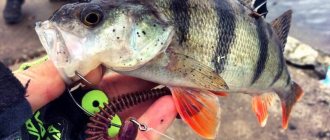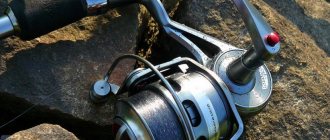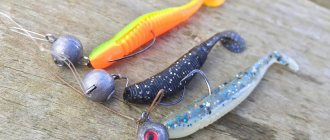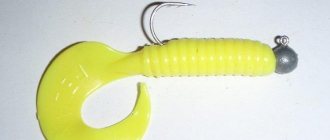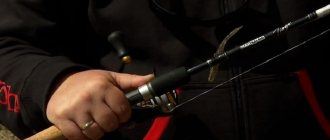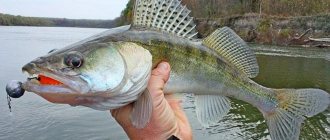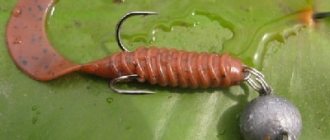A jig hook or a fishing hook for a jig is structurally special, not the most popular element of jig equipment, but worthy of attention.
It is slightly inferior to its offset brother, but has its own unique and noteworthy features that can reliably “hook” a predator, hold it when hooked and facilitate the difficult process of fishing. What is a fishing hook for jig fishing, what is its uniqueness and advantage over other fishing hooks, what to look for when purchasing this important piece of jig equipment - read in this article.
What is a jig fishing hook?
A jig hook (jig hook) or European style jig hook is one of the types of fishing hooks used in equipment for jig fishing, designed for attaching jig baits (slugs, creatures, vibrotails, twisters, silicone worms).
Jig hooks
Jig hooks.
Jig hooks are popular among spinners - fans of jig fishing, as well as sports fishermen. The shape for jig heads is usually made for a specific hook or for several that are similar in size. Hooks from different manufacturers that have the same marking , for example 4/0, may differ from each other in wire thickness, be of different lengths, etc. Even from one manufacturer 4/0 in different series is not
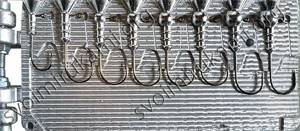
similar to each other. When designing a mold, it is necessary to know exactly the distance from the fore-end to the edge of the ring, the diameter of the ring, the length of the fore-end to the bend, and the thickness of the wire. These 4 basic parameters are necessary for the successful design and manufacture of a jig head mold.
Nowadays the most popular form of hook called Barbarian. This hook has a curved shape. The bend on the fore-end is located where the hook comes out of the silicone bait. The second bend prevents the hook from unbending, makes it stiffer and increases the penetration of fish.
The hooks are round in shape; the silicone bait often slips off them or simply begins to dangle, but it hurts the fish less. The hook, thanks to its smooth curve, passes more easily from the sting to the bend through the lip of the fish. The thickness of the hook for the upcoming fishing should be chosen depending on what kind of fish you are going to catch. You also need to take into account the rockiness of the reservoir for the upcoming fishing. The thinner the hook, the better it springs and the greater the likelihood of it being unhooked in a snag. The hook is usually released by pulling on the line, holding it with the hook open, and then quickly releasing it. The hook compresses like a spring and when the fishing line is suddenly loosened, it bounces back. If the line is strong and the hook is made of thin wire, it may bend. Then it can easily be returned to its original position. In this case, the bait and hook will remain intact. If the hook remains absolutely sharp, it can be used further.
Many anglers ask for a small weight jig head, 1-2-3 grams on a large 5/0-6/0 hook. In this case, the weight of lead is considered, because the hook itself weighs up to 1 g. Such jig heads are used in the cold season, when predators become more active and larger baits are needed.
How not to be left without a catch while fishing!
Fishing is, above all, fun. Real fishermen are not envious people and can rejoice in the success of other fishermen. The process itself requires careful preparation and thinking through all the little things , such as preparing gear, choosing a fishing spot, a parking spot if you plan to travel for several days, and you also need to take into account weather conditions, because they can greatly affect the outcome of the planned event.
A long absence of rain indicates that the water level has dropped and the fish are rolling into holes or are at the bottom; the fisherman’s task is to find such places and try to catch them. The fish do not bite very actively during spring and summer fogs. On the contrary, thick fogs in autumn have a beneficial effect on the appetite of fish and, on the contrary, the bite weakens while the fog dissipates.
The fish tries to find solitude in quiet places during strong winds or during thunderstorms, such as holes and reeds. She stops pecking during prolonged bad weather, becoming inactive and lethargic. The southwest wind has a beneficial effect on the bite, the north and east – on the contrary.
In autumn, the water temperature drops, the fish actively feed in order to gain fat before winter. In the spring, when the water becomes clear, despite the winds and cold, the fish also begin to look for food after the winter food shortage. In the warm season, the bite is better in the early morning, when the water has not yet had time to warm up under the rays of the sun, and closer to night, when the water cools down a little. During the day, the fish hides in cooler places. Sometimes the fish does not behave as expected: in good weather it does not bite, but as soon as the weather changes to bad, the bite begins. The fish become active during rains after a long absence. During heavy, prolonged rains, the fish go into the thickets, the water level rises, and the bite weakens. An important factor influencing the activity of fish is atmospheric pressure. High water makes the fish sluggish, it goes deep to the bottom. Low pressure can bring fishermen a good catch. If the barometer reading is below 75 mmHg, then you can safely go fishing. But you should refuse if it is above 770 mmHg. Sudden pressure surges worsen the bite.
What are the different forms of hooks for jig fishing?
The hook for soft (silicone) baits does not differ significantly from classic fishing hooks; it also has a sting, shank, eye and other elements typical of a hook. The design feature of the jig hook is its angular bend at the underhook, thanks to which jig baits are held more securely and do not slip when casting; this feature also allows them to withstand significant loads in the process of fishing for a predator and serves to prevent the hook from unbending. The closer this bend is to the shank of the hook, the less danger of losing the desired prey. Also, the eye of the hook is located at an angle of 90 degrees from the fore-end, which has a positive effect on the reliability of attaching the bait.
This is what the design of one type of jig hook looks like
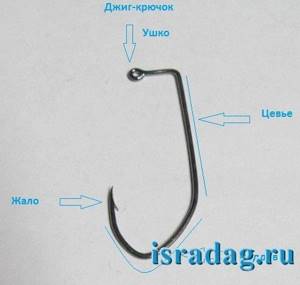
In addition to these “angular” hooks, hooks with rounded shapes are also successfully used in jig fishing.
However, such hooks are inferior to “angular” ones and often the bait slides off them. They also have a humane advantage, which consists in the roundness of the hook; thanks to this feature, minor wounds are formed in the caught prey when hooked, and the hook easily passes through the lip of the fish.
The universal form of these hooks are the hooks from the manufacturer dreamtakle, which combine bending and roundness of the hook.
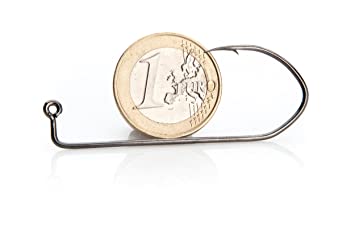
There is also an interesting form of hook, which involves the presence of a hook in the central part of the fore-end.
Hook
The hook is one of the greatest inventions of mankind. Without this detail, fishing will not work. However, the hook itself does not catch. This leads to the next task of the fisherman - not to oversleep and make a hook. The fact is that self-hooking can create the false impression that the fish is securely held on the hook and will not run away on the way to the fisherman (and his camera). So, you need to understand that the hook must be very sharp and capable of holding the caught fish when fishing, and the fisherman must be as attentive as possible.
From personal practice I can conclude that it is preferable to use a single hook. Why is that? One reason in favor of this is the easier installation of the bait with a hook. Below we will talk about special single hooks, which are especially suitable for jigging in areas with poor traffic for your bait. There is another important point - reliable grip. In this parameter, a single hook has an advantage over a double or tee, since the force transmitted during hooking is not distributed over several points, but will be entirely concentrated in only one - where the single hook enters the mouth of the trophy. The same advantage occurs when playing. That’s why I recommend using a single hook in jig fishing.
What are the different types of stings on jig hooks?
Cone Cut or Cut Point - the sting is cut at an angle, which makes it sharper. This is the most common form of sting.
Needle cone sting from VMC manufacturers and from OWNER manufacturers Needle point tip - super sharp and durable tip
Tip from OWNER 5417/5404 and VMC sparkpoint
Is the length of the tip important? Of course, many anglers may argue that the longer it is, the better and means sharper, but for jig fishing this can be a problem, because when pierced into the strong jaw of a predator, the long sting can easily bend. Also, the very specificity of jig fishing involves serious loads on the hook in the form of hooks, hooking, and landing fish.
Adviсe:
- if you run your finger from the barb to the curved sting and your finger gets caught, then the sting is bent and can be straightened;
- In order to straighten this part of the hook, you can use pliers by dragging this slightly compressed tool from the barb to the tip.
Cargo
As for the loads used in jig fishing, it is quite sufficient in our conditions, and therefore the most popular is the load in the shape of a ball. Therefore, it is this form that we will consider when studying a tandem consisting of a load and a hook, using the example of a hinged joint. What are the practical advantages of this particular version? First of all, it is the convenience of using offset hooks. There is nothing special to describe here: there is a need for such hooks - you take the ring, connect it to the load, and the equipment is ready. The next advantage is the ability to install hooks of various sizes with loads of the required weight in a particular case. In other words, you can create the desired configuration from a minimum set of components, which means you don’t have to carry around extra weight. For example, it is very difficult to find a jig head weighing between 6-8 g with a 5/0 hook, but when fishing for pike this combination is very often in demand. And you can assemble such equipment yourself using a swivel joint. Because of the wire “ears” protruding from the ball weight, the weight used in such a connection is popularly nicknamed “Cheburashka”. So, not all Cheburashkas are the same. And the best ones are those whose “ear” rings for connection are located at an angle of 90 degrees relative to each other.
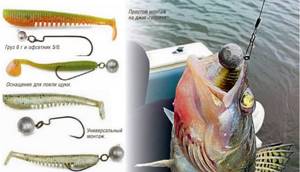
I’ll add a few more words about the difference in installation depending on the type of intended trophy. If it is a pike, then the best result is obtained by using an offset hook with a straight bend (for example, the mentioned Owner/C'ultiva 5191 Z-Neck series). But! When connecting to a load, the hook must be located strictly in a horizontal plane.
This is where “Cheburashka” weights with “ears” turned in different directions come in handy. If the “ears” are made of good quality wire, then it is easy for the fisherman to turn one of them, if necessary, right on the spot.
Thickness (wire) of jig hook
Is the thickness of the wire important? It is important because the penetration of the hook into the mouth cavity of the fish depends on this, that is, the thinner the material, the easier it penetrates and vice versa. Also, at the moment of hooking, the tip of a thin hook clings to the obstacle, while a thick hook can simply break off.
Thus, when choosing the thickness of the hook, be guided by:
- The magnitude of future production.
- Fishing place (snag, etc.).
The springiness of the jig hook is also affected by the fishing line (monoline or braided line). To release the rig, you need to tighten the line using your best spinning rod for jigging and hold it with the open arm of a spinning or multiplier reel. Then sharply lower the tackle, which will help the thin hook to jump off, but the thick one will sink into the hook even more strongly.
Thus, the required jig hook is selected exclusively for the characteristics of the spinning rod and the size (power) of the future prey.
Types of Jig Head Hooks
Single
Jig heads with single hooks are the most common type of jig heads (second most popular are snap-on jig heads with offset hooks). Ordinary singles are also used in microjigs together with an eared sinker, with a pellet sinker located on the fishing line, when fishing with lead rigs and when fishing without weight.
When using a single hook instead of a double hook, the number of snags on grass and snags is significantly reduced, and the hook gets caught in the fishing line less often during casting.
Singles used in jig heads can have one, two or three notches on the fore-end, thanks to which the bait stays better on the hook and does not slip.
Double
Doubles are the main type of hook used in jig fishing with eared sinkers.
When fishing with silicone baits or foam fish, double hooks can be left open; the use of non-snacking baits, which are made from foam rubber and double hooks with hooks pressed to the body of the foam rubber fish, is also widespread.
In jig fishing, doubles with elongated shanks , with which the installation of jig baits is as convenient as possible.
Offset
Offset hooks are specially shaped hooks with a bend on the fore-end, which are designed to create non-snagging baits .
Offset hooks are optimal for fishing both in thick snags and among grass thickets and in other strong places.
On sale you can find jig heads with offset hooks; in addition, offset hooks are used in combination with eared sinkers.
Dimensions
The hook size in jig fishing is selected according to the size of the bait . In addition, you should take into account the fishing conditions (how often snags occur) and the activity of the fish. Larger hooks provide a high percentage of bites, but also give a large number of hooks on grass, snags and other obstacles. The use of smaller hooks reduces the number of hooks and leads to an increase in the number of derailments.
The following numbering of hooks for jig fishing is common: No. 10, 9, 8, 7, 6, 5, 4, 3, 2, 1, 1/0, 2/0, 3/0, 4/0, 5/0. In this row, hook number 10 is the smallest, and 5/0 is the largest. It should be noted that different companies designate the sizes of hooks they produce differently; for example, the Eagle Claw numbering differs from the Cannelle and VMC numbering.
Numbering of Gamakatsu hooks
Gamakatsu is widely known for producing quality hooks and jig heads for both freshwater and saltwater fishing, designed for recreational and sports anglers .
The company uses standard numbering of hooks - from No. 10 to No. 5/0. The company's catalog also includes larger hooks, but the most popular products are jig heads with hooks from No. 2/0 to No. 5/0.
- Jig head 2/0 – hook length 35 mm, suitable for fishing with medium and small baits.
- 3/0 – hook length 38 mm, suitable for mounting medium-sized silicone baits.
- 4/0 – hook length 43 mm. Also good for medium sized lures.
- 5/0 – hook length 48 mm. The head is suitable for fishing with large worms and large vibrotails.

